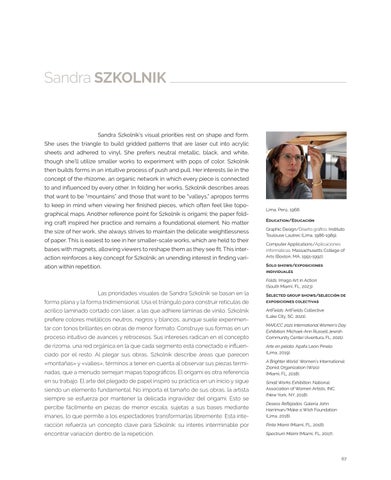Sandra SZKOLNIK
Sandra Szkolnik’s visual priorities rest on shape and form. She uses the triangle to build gridded patterns that are laser cut into acrylic sheets and adhered to vinyl. She prefers neutral metallic, black, and white, though she’ll utilize smaller works to experiment with pops of color. Szkolnik then builds forms in an intuitive process of push and pull. Her interests lie in the concept of the rhizome, an organic network in which every piece is connected to and influenced by every other. In folding her works, Szkolnik describes areas that want to be “mountains” and those that want to be “valleys,” apropos terms to keep in mind when viewing her finished pieces, which often feel like topographical maps. Another reference point for Szkolnik is origami; the paper fold-
Lima, Perú, 1968.
ing craft inspired her practice and remains a foundational element. No matter
Education/Educación
the size of her work, she always strives to maintain the delicate weightlessness
Graphic Design/Diseño gráfico. Instituto Toulouse Lautrec (Lima, 1986-1989).
of paper. This is easiest to see in her smaller-scale works, which are held to their bases with magnets, allowing viewers to reshape them as they see fit. This interaction reinforces a key concept for Szkolnik; an unending interest in finding variation within repetition.
Computer Applications/Aplicaciones informáticas. Massachusetts College of Arts (Boston, MA, 1991-1992). Solo shows/exposiciones individuales Folds. Imago Art in Action (South Miami, FL, 2023).
Las prioridades visuales de Sandra Szkolnik se basan en la forma plana y la forma tridimensional. Usa el triángulo para construir retículas de acrílico laminado cortado con láser, a las que adhiere láminas de vinilo. Szkolnik prefiere colores metálicos neutros, negros y blancos, aunque suele experimentar con tonos brillantes en obras de menor formato. Construye sus formas en un proceso intuitivo de avances y retrocesos. Sus intereses radican en el concepto de rizoma, una red orgánica en la que cada segmento está conectado e influenciado por el resto. Al plegar sus obras, Szkolnik describe áreas que parecen «montañas» y «valles», términos a tener en cuenta al observar sus piezas terminadas, que a menudo semejan mapas topográficos. El origami es otra referencia en su trabajo. El arte del plegado de papel inspiró su práctica en un inicio y sigue siendo un elemento fundamental. No importa el tamaño de sus obras, la artista siempre se esfuerza por mantener la delicada ingravidez del origami. Esto se
Selected group shows/selección de exposiciones colectivas ArtFields. ArtFields Collective (Lake City, SC, 2021). MARJCC 2021 International Women’s Day Exhibition. Michael-Ann Russell Jewish Community Center (Aventura, FL, 2021). Arte en pelota. Apafa León Pinelo (Lima, 2019). A Brighter World. Women’s International Zionist Organization (Wizo) (Miami, FL, 2018). Small Works Exhibition. National Association of Women Artists, INC. (New York, NY, 2018).
imanes, lo que permite a los espectadores transformarlas libremente. Esta inte-
Deseos Reflejados. Galería John Harriman/Make a Wish Foundation (Lima, 2018).
racción refuerza un concepto clave para Szkolnik: su interés interminable por
Pinta Miami (Miami, FL, 2018).
encontrar variación dentro de la repetición.
Spectrum Miami (Miami, FL, 2017).
percibe fácilmente en piezas de menor escala, sujetas a sus bases mediante
67
















